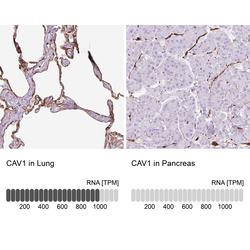Antibody data
- Antibody Data
- Antigen structure
- References [6]
- Comments [0]
- Validations
- Immunohistochemistry [1]
Submit
Validation data
Reference
Comment
Report error
- Product number
- HPA049326 - Provider product page

- Provider
- Atlas Antibodies
- Proper citation
- Atlas Antibodies Cat#HPA049326, RRID:AB_2680714
- Product name
- Anti-CAV1
- Antibody type
- Polyclonal
- Description
- Polyclonal Antibody against Human CAV1, Gene description: caveolin 1, caveolae protein, 22kDa, Alternative Gene Names: CAV, Validated applications: WB, IHC, Uniprot ID: Q03135, Storage: Store at +4°C for short term storage. Long time storage is recommended at -20°C.
- Reactivity
- Human
- Host
- Rabbit
- Conjugate
- Unconjugated
- Isotype
- IgG
- Vial size
- 100 µl
- Concentration
- 0.1 mg/ml
- Storage
- Store at +4°C for short term storage. Long time storage is recommended at -20°C.
- Handling
- The antibody solution should be gently mixed before use.
Submitted references Downregulation of Caveolae-Associated Proteins in Psoriasis: A Case Series Study
Methylation pattern of Caveolin-1 in prostate cancer as potential cfDNA biomarker
Glucocorticoid-mediated induction of caveolin-1 disrupts cytoskeletal organization, inhibits cell migration and re-epithelialization of non-healing wounds
The importance of caveolins and caveolae to dermatology: Lessons from the caves and beyond
Multimodal, in Situ Imaging of Ex Vivo Human Skin Reveals Decrease of Cholesterol Sulfate in the Neoepithelium during Acute Wound Healing
Pharmacological and Genetic Inhibition of Caveolin-1 Promotes Epithelialization and Wound Closure
Lin D, Abujamra B, Revah S, Nattkemper L, Morrison B, Romanelli P, Jozic I
JID Innovations 2024;4(2):100265
JID Innovations 2024;4(2):100265
Methylation pattern of Caveolin-1 in prostate cancer as potential cfDNA biomarker
Škara L, Vodopić T, Pezelj I, Abramovic I, Vrhovec B, Vrtarić A, Sincic N, Tomas D, Bulimbašić S, Kuliš T, Ulamec M
Bosnian Journal of Basic Medical Sciences 2022
Bosnian Journal of Basic Medical Sciences 2022
Glucocorticoid-mediated induction of caveolin-1 disrupts cytoskeletal organization, inhibits cell migration and re-epithelialization of non-healing wounds
Jozic I, Abujamra B, Elliott M, Wikramanayake T, Marjanovic J, Stone R, Head C, Pastar I, Kirsner R, Andreopoulos F, Musi J, Tomic-Canic M
Communications Biology 2021;4(1)
Communications Biology 2021;4(1)
The importance of caveolins and caveolae to dermatology: Lessons from the caves and beyond
Egger A, Rajabi‐Estarabadi A, Williams N, Resnik S, Fox J, Wong L, Jozic I
Experimental Dermatology 2020;29(2):136-148
Experimental Dermatology 2020;29(2):136-148
Multimodal, in Situ Imaging of Ex Vivo Human Skin Reveals Decrease of Cholesterol Sulfate in the Neoepithelium during Acute Wound Healing
Castellanos A, Hernandez M, Tomic-Canic M, Jozic I, Fernandez-Lima F
Analytical Chemistry 2019;92(1):1386-1394
Analytical Chemistry 2019;92(1):1386-1394
Pharmacological and Genetic Inhibition of Caveolin-1 Promotes Epithelialization and Wound Closure
Jozic I, Sawaya A, Pastar I, Head C, Wong L, Glinos G, Wikramanayake T, Brem H, Kirsner R, Tomic-Canic M
Molecular Therapy 2019;27(11):1992-2004
Molecular Therapy 2019;27(11):1992-2004
No comments: Submit comment
Supportive validation
- Submitted by
- Atlas Antibodies (provider)
- Enhanced method
- Orthogonal validation
- Main image

- Experimental details
- Immunohistochemistry analysis in human lung and pancreas tissues using HPA049326 antibody. Corresponding CAV1 RNA-seq data are presented for the same tissues.
- Sample type
- Human
- Protocol
- Protocol
 Explore
Explore Validate
Validate Learn
Learn Western blot
Western blot Immunohistochemistry
Immunohistochemistry